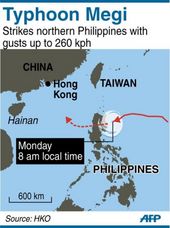
© HKO/Agence France-PresseMap showing the path of Typhoon Megi as it crashes into the Philippines
Super Typhoon Megi slammed into the northern Philippines Monday causing landslides in mountainous areas, tearing roofs off houses, whipping up huge waves along the coast and killing at least one person.
Schools were closed and thousands of people were evacuated across the north of the Philippines' main island of Luzon ahead of the strongest storm to pummel the country this year, rescue and relief officials said.
The northeastern provinces of Isabela and Cagayan were the first to feel the typhoon's fury on Monday morning, chief government weatherman Graciano Yumol said.
"There are landslides in the mountains, we have swells, storm surges and big waves along the coast line, and now we have flood alerts," Yumol said in an interview with GMA 7 television.
In the northern city of Tuguegarao in Cagayan, a man drowned in a river while fishing, the nation's civil defence chief, Benito Ramos, told reporters in Manila.
Television footage showed motorised tricycles overturned and tin roofing blown away by the strong winds in Isabela.
The storm, dubbed a "super-typhoon" by government relief agencies, was packing gusts of up to 260 kilometres (160 miles) per hour, the government weather station said.
Megi was expected to dump heavy rain across the northern part of Luzon throughout Monday, then head towards southern China on Tuesday, the weather station said.
More than 1,100 people were killed when Tropical Storm Ketsana and Typhoon Parma struck Manila and other parts of Luzon within a week of each other last year, triggering the worst flooding in recent history.
Remote mountain towns were cut off Monday after being hit by landslides, local police and residents reported.
"We are marooned inside our home. We can not go out. The winds and rain are very strong. Many trees are being uprooted or snapped in half," Ernesto Macadangdang, a resident of Burgos town in Isabela, told DZBB radio.
He said power had been cut off since Sunday night, but telephone lines were still working.
As of 11:30 am (0330 GMT) Monday, the government weather station tracked Megi hitting the Sierra Madre mountains in Isabela, about 360 kilometres north of the capital, Manila.
The highest level of a four-step storm alert was raised over Isabela, Cagayan and surrounding provinces while lower alerts were in effect over most of Luzon.
Isabela and other provinces in Megi's direct path are mostly agricultural and fishing areas, with a few million residents who are well-drilled in preparing for the many storms that hit each year.
Over 3,000 people had already been moved from their homes in the northern provinces as part of a "pre-emptive evacuation" of threatened areas, the civil defence office said.
Flights to and from northern Luzon were also suspended and ships there were told not to leave port.
Military, police and relief agencies had positioned supplies and rescue units to provide swift assistance to any affected areas, the civil defence office reported.
Rubber boats, large trucks, heavy equipment and rescue divers were all on standby, ready to be dispatched to areas hit by floods or blocked by landslides, the office said.
Deputy military chief Lieutenant General Reynaldo Mapagu said that the US military had offered six C-46 helicopters to help if needed.
The storm was not expected to hit Manila directly but government forecaster Yumol warned the city's 12 million residents to remain on alert.
"It will rain here as well so do not lower your preparations," he said.
The Philippines is battered by an average of 20 typhoons a year, some of them deadly.
Reader Comments
to our Newsletter